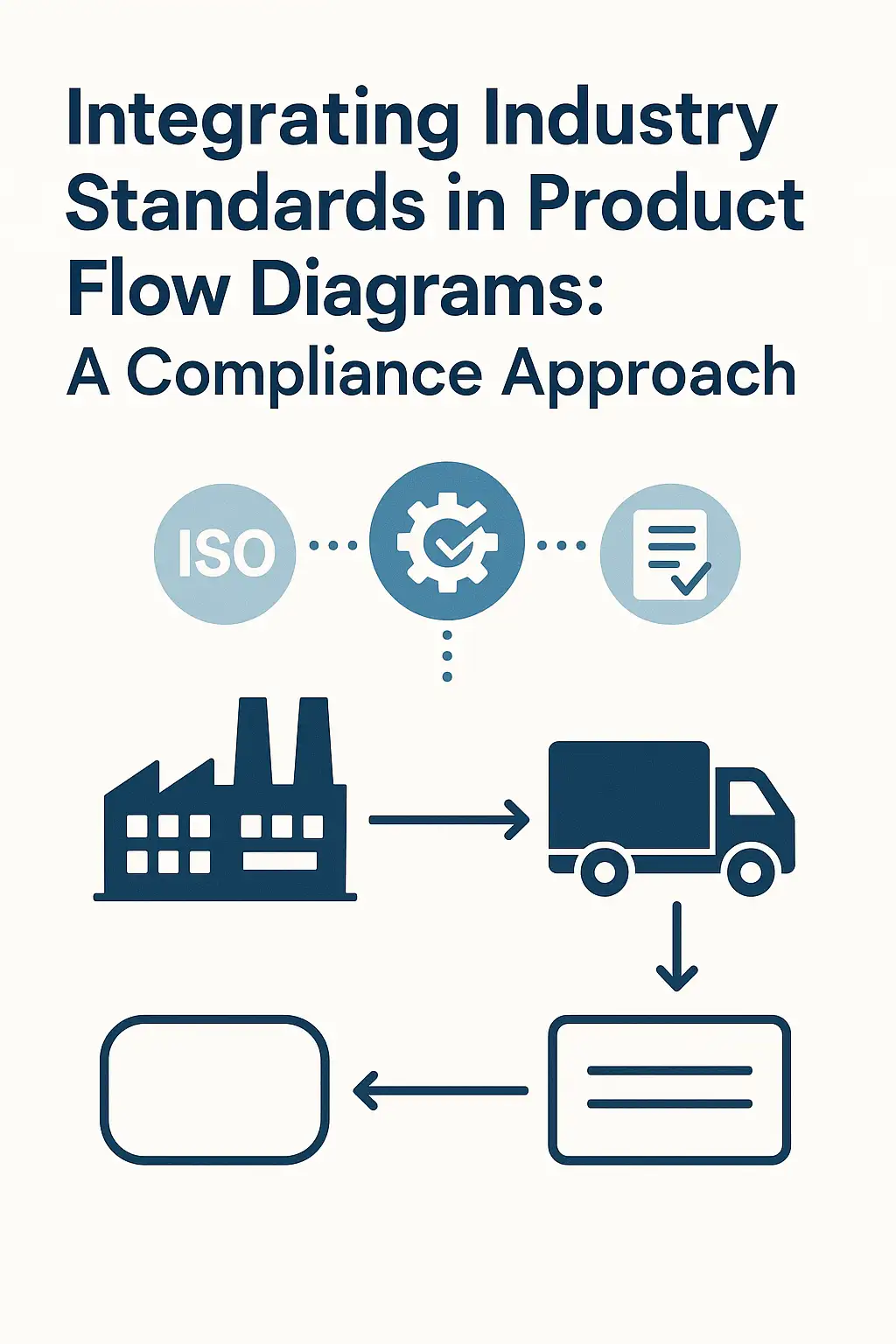Introduction
Effective communication and clarity are paramount. One of the essential tools that facilitate this is the Product Flow Diagram (PFD). A PFD is a visual representation that outlines the sequence of processes involved in the production and delivery of a product. It serves as a roadmap, illustrating how various components interact and flow from one stage to another, ultimately leading to the final product. By providing a clear depiction of workflows, PFDs help project managers and teams identify potential bottlenecks, streamline operations, and enhance overall efficiency.
The role of product flow diagrams in project management extends beyond mere visualization. They are instrumental in planning, executing, and monitoring projects, ensuring that all stakeholders have a shared understanding of the processes involved. PFDs aid in risk management by highlighting critical paths and dependencies, allowing project managers to allocate resources effectively and anticipate challenges. Furthermore, they serve as a communication tool that bridges the gap between technical and non-technical team members, fostering collaboration and informed decision-making.
As industries evolve, the importance of adhering to industry standards and compliance regulations becomes increasingly significant. Industry standards provide a framework for best practices, ensuring that processes are not only efficient but also safe and reliable. Compliance with these standards is crucial for organizations to maintain quality, meet regulatory requirements, and mitigate risks. When creating product flow diagrams, integrating these standards is essential. It ensures that the diagrams not only reflect the operational realities of the project but also align with legal and industry-specific requirements. This compliance approach not only enhances the credibility of the project but also protects the organization from potential legal and financial repercussions.
Understanding Industry Standards
When developing product flow diagrams, adherence to industry standards is crucial. These standards not only guide the creation of effective diagrams but also ensure that the processes they represent meet quality and compliance requirements. Below, we explore key industry standards relevant to product flow diagrams, their purposes, and the implications of non-compliance.
Key Industry Standards
- ISO (International Organization for Standardization):
- ISO 9001: This standard focuses on quality management systems and emphasizes the importance of consistent quality in products and services. It provides a framework for organizations to ensure that their processes, including those represented in flow diagrams, meet customer and regulatory requirements.
- ISO 31000: This standard offers guidelines on risk management, which is essential for identifying potential risks in project processes. Flow diagrams can be used to visualize these risks and ensure that they are managed effectively.
- CMMI (Capability Maturity Model Integration): CMMI is a process improvement framework that helps organizations improve their performance. It provides a structured approach to process improvement, which can be reflected in product flow diagrams. By following CMMI practices, project managers can ensure that their diagrams support continuous improvement and operational excellence.
- PMBOK (Project Management Body of Knowledge): The PMBOK Guide outlines best practices in project management, including the use of flow diagrams for process mapping. It emphasizes the importance of standardization in project processes, which can enhance communication and understanding among stakeholders.
- Six Sigma: This methodology focuses on process improvement and reducing defects. Flow diagrams are often used in Six Sigma projects to identify areas for improvement and streamline processes. Adhering to Six Sigma principles can lead to more efficient and effective product flow diagrams.
Purpose of Industry Standards
The primary purpose of these industry standards is to promote quality and consistency across projects. By adhering to established guidelines, organizations can:
- Enhance Quality: Standards like ISO 9001 ensure that processes are designed to meet quality benchmarks, leading to better products and services.
- Facilitate Communication: Standardized flow diagrams provide a common language for project teams, stakeholders, and compliance officers, reducing misunderstandings and errors.
- Support Compliance: Many industries are subject to regulatory requirements. Adhering to standards helps organizations demonstrate compliance, which is critical for avoiding legal issues and maintaining market reputation.
Consequences of Non-Compliance
Failing to adhere to industry standards when creating product flow diagrams can have significant repercussions:
- Quality Issues: Non-compliance can lead to inconsistencies in product quality, resulting in customer dissatisfaction and potential loss of business.
- Increased Risks: Without proper adherence to risk management standards, organizations may overlook critical risks, leading to project failures or safety incidents.
- Legal and Financial Penalties: Regulatory bodies may impose fines or sanctions on organizations that fail to comply with industry standards, which can have severe financial implications.
- Reputational Damage: Non-compliance can tarnish an organization’s reputation, making it difficult to attract new clients or retain existing ones.
The Importance of Compliance in Product Flow Diagrams
When developing product flow diagrams, adherence to industry standards is not merely a best practice; it is a critical component that ensures the integrity and effectiveness of project documentation. For compliance officers and project managers, understanding the significance of compliance in this context is essential for several reasons:
- Ensuring Accuracy in Project Documentation: Compliance with established industry standards guarantees that product flow diagrams are created with precision and clarity. Accurate documentation is vital for conveying the intended processes and workflows, which helps prevent misunderstandings and errors during project execution. When diagrams adhere to recognized standards, they provide a consistent framework that all stakeholders can understand, thereby reducing the likelihood of miscommunication and enhancing overall project efficiency.
- Role of Compliance in Risk Management: Compliance plays a pivotal role in identifying and mitigating risks associated with project workflows. By following industry standards, project managers can systematically assess potential risks and implement controls that align with regulatory requirements. This proactive approach not only safeguards the project from potential legal and financial repercussions but also fosters a culture of accountability and transparency. Compliance-driven product flow diagrams can serve as a tool for risk assessment, allowing teams to visualize and address vulnerabilities before they escalate into significant issues.
- Enhancing Stakeholder Confidence: Adhering to industry standards in product flow diagrams significantly boosts stakeholder confidence. When stakeholders see that a project is being managed in accordance with recognized compliance frameworks, they are more likely to trust the project’s outcomes. This trust is crucial for securing buy-in from investors, clients, and team members, as it demonstrates a commitment to quality and reliability. Furthermore, compliance can enhance the organization’s reputation, positioning it as a leader in best practices within its industry.
Best Practices for Creating Compliant Product Flow Diagrams
Creating product flow diagrams that adhere to industry standards is crucial for ensuring compliance and enhancing project management efficiency. Here are actionable strategies to help compliance officers and project managers develop compliant product flow diagrams:
1. Identify Applicable Industry Standards
- Research Relevant Standards: Begin by identifying the industry standards that apply to your specific project. This may include ISO standards, regulatory requirements, or industry-specific guidelines. Utilize resources such as industry associations, regulatory bodies, and compliance frameworks to gather information.
- Engage Stakeholders: Collaborate with stakeholders, including compliance officers, legal teams, and subject matter experts, to ensure that all relevant standards are considered. Their insights can help clarify which standards are most pertinent to your project.
- Document Standards: Create a comprehensive list of the identified standards and their specific requirements. This documentation will serve as a reference throughout the diagram creation process, ensuring that all aspects of compliance are addressed.
2. Utilize Tools and Software for Compliance
- Flowchart Software: Leverage specialized flowchart software that includes templates and features designed to meet industry standards. Tools like Lucidchart, Microsoft Visio, and SmartDraw offer functionalities that can help streamline the creation of compliant diagrams.
- Compliance Management Tools: Consider using compliance management software that integrates with your diagramming tools. These platforms can provide checklists, guidelines, and automated compliance checks to ensure that your diagrams align with industry standards.
- Version Control Systems: Implement version control systems to track changes in your diagrams. This practice not only aids in maintaining compliance but also ensures that all team members are working with the most current version of the diagram.
3. Review and Validate Diagrams Against Standards
- Conduct Peer Reviews: Establish a peer review process where team members can evaluate the product flow diagrams against the identified standards. This collaborative approach can help identify potential compliance issues early in the process.
- Utilize Checklists: Develop a compliance checklist based on the identified standards. Use this checklist to systematically review each element of the diagram, ensuring that all requirements are met before finalizing the document.
- Seek External Validation: If necessary, consider engaging external compliance experts to review your diagrams. Their objective perspective can provide valuable insights and help ensure that your diagrams meet all regulatory requirements.
By following these best practices, compliance officers and project managers can create product flow diagrams that not only meet industry standards but also enhance the overall effectiveness of project management efforts. Adhering to these strategies will facilitate smoother project execution and mitigate compliance risks.
Common Pitfalls and How to Avoid Them
Creating product flow diagrams is a critical aspect of project management, particularly for compliance officers and project managers who must ensure adherence to industry standards. However, there are several common pitfalls that can undermine the effectiveness of these diagrams and lead to compliance issues. Here are some frequent mistakes and strategies to avoid them:
1. Inadequate Understanding of Industry Standards
- Pitfall: Many project managers may not fully understand the specific industry standards that apply to their product flow diagrams. This can lead to diagrams that do not meet regulatory requirements, resulting in compliance failures.
- Solution: Conduct thorough research on relevant industry standards before creating flow diagrams. Utilize resources such as industry publications, regulatory guidelines, and best practice frameworks to ensure a comprehensive understanding of the requirements.
2. Lack of Stakeholder Involvement
- Pitfall: Failing to involve key stakeholders in the diagram creation process can lead to incomplete or inaccurate representations of product flows. This oversight can result in miscommunication and compliance risks.
- Solution: Engage stakeholders from various departments, including compliance, operations, and quality assurance, during the diagram development process. Regular workshops and feedback sessions can help ensure that all perspectives are considered and that the diagram accurately reflects the product flow.
3. Overcomplicating Diagrams
- Pitfall: Some project managers may create overly complex diagrams that are difficult to interpret. This can obscure critical compliance information and hinder effective communication among team members.
- Solution: Strive for clarity and simplicity in your diagrams. Use standardized symbols and notations, and limit the number of elements to only those that are necessary for understanding the product flow. Consider using color coding or annotations to highlight compliance-related aspects without cluttering the diagram.
4. Neglecting Updates and Revisions
- Pitfall: Once a product flow diagram is created, it is often neglected, leading to outdated information that does not reflect current processes or compliance requirements. This can result in significant compliance risks.
- Solution: Implement a regular review process for product flow diagrams. Schedule periodic updates to ensure that the diagrams remain accurate and compliant with any changes in industry standards or internal processes. Encourage team members to report any changes in product flow that may necessitate a revision.
5. Insufficient Training and Education
- Pitfall: A lack of training on the importance of compliance in product flow diagrams can lead to mistakes and oversights. Team members may not be aware of the implications of non-compliance.
- Solution: Invest in ongoing training and education for all team members involved in creating and using product flow diagrams. This can include workshops, online courses, and access to resources that cover industry standards, compliance requirements, and best practices in diagram creation.
Future Trends in Compliance and Product Flow Diagrams
When it comes to creating product flow diagrams, adherence to industry standards is not just a best practice; it is a necessity. As compliance officers and project managers navigate the complexities of regulatory environments, understanding future trends in compliance and product flow diagrams becomes crucial. Here are some key points to consider:
Influence of Technology on Compliance Practices
- Automation and AI Integration: The rise of automation and artificial intelligence is transforming how compliance is managed. Tools that automate the creation and updating of product flow diagrams can ensure that they remain aligned with current regulations, reducing the risk of human error. AI can also analyze compliance data to identify potential issues before they become problematic, allowing for proactive adjustments in project management practices.
- Cloud-Based Solutions: The shift towards cloud-based project management tools facilitates real-time collaboration and updates. This technology enables teams to access the most current compliance standards and integrate them into product flow diagrams seamlessly. As remote work becomes more prevalent, these solutions will be essential for maintaining compliance across distributed teams.
Emerging Standards and Regulations
- Increased Regulatory Scrutiny: As industries evolve, so do the regulations governing them. Emerging standards, particularly in sectors like healthcare, finance, and technology, are becoming more stringent. Compliance officers must stay informed about these changes to ensure that product flow diagrams reflect the latest requirements. This includes understanding new data protection laws, environmental regulations, and industry-specific guidelines.
- Sustainability Standards: With a growing emphasis on sustainability, new compliance standards are emerging that require organizations to consider environmental impacts in their product flow diagrams. This trend will necessitate a shift in how project managers approach diagram creation, incorporating sustainability metrics and compliance into their workflows.
Speculating on the Future of Project Management and Compliance Integration
- Holistic Compliance Frameworks: The future of project management will likely see a move towards more integrated compliance frameworks. This means that compliance will not be an afterthought but rather a core component of project planning and execution. Product flow diagrams will evolve to include compliance checkpoints, ensuring that all stages of the project adhere to relevant standards.
- Data-Driven Decision Making: As data analytics becomes more sophisticated, project managers will increasingly rely on data-driven insights to inform compliance practices. This trend will lead to more dynamic product flow diagrams that can adapt to changing regulations and compliance requirements in real-time.
- Collaboration Across Disciplines: The integration of compliance into product flow diagrams will require collaboration between various departments, including legal, operations, and project management. This interdisciplinary approach will foster a culture of compliance that permeates the organization, ensuring that all stakeholders are aligned and informed.
Conclusion
When it comes to creating product flow diagrams, adherence to industry standards is not merely a best practice; it is a critical component of ensuring compliance and operational efficiency. As we have explored, these standards provide a framework that enhances clarity, consistency, and communication among stakeholders, ultimately leading to more successful project outcomes.
- Importance of Adherence: Compliance with industry standards in product flow diagrams helps mitigate risks associated with non-compliance, such as legal repercussions and project delays. By aligning with established guidelines, project managers and compliance officers can ensure that their diagrams accurately represent processes, facilitating better decision-making and resource allocation.
- Encouraging Proactive Measures: It is essential for compliance officers and project managers to take proactive measures in their approach to product flow diagrams. This includes regular training on industry standards, conducting audits of existing diagrams, and fostering a culture of compliance within their teams. By prioritizing these actions, organizations can enhance their operational integrity and reduce the likelihood of compliance issues arising.
In conclusion, integrating industry standards into product flow diagrams is not just about compliance; it is about fostering a culture of excellence and accountability in project management. By committing to these standards, compliance officers and project managers can drive their organizations toward greater success and sustainability.
Find out more about Shaun Stoltz https://www.shaunstoltz.com/about/.
This post was written by an AI and reviewed/edited by a human.



